
The Sample Landscape 2021 – Marijuana Legalization Over the Years
May 28, 2021
Intellicast S4E20: Data Quality Trends and MR Acquisitions
June 8, 2021Brands position themselves to stand for something—usually something that will help them connect with their consumers. Some of these brands position themselves as patriotic. In our latest round of research on research we explored opinions of certain brands and whether or not they are considered patriotic.
In this blog, we look at changes in opinion from 2019 through 2021 based on gender, political party, income, and region.
NFL
Total perceived patriotism of the NFL increased from 2019 to 2020, but in the following year the percent of respondents who believe the NFL to be a patriotic brand has decreased by 5%.

Both male and female respondents have experienced a decrease in their consideration of the NFL as a patriotic brand in the past year – males by 4% and females by 6%.
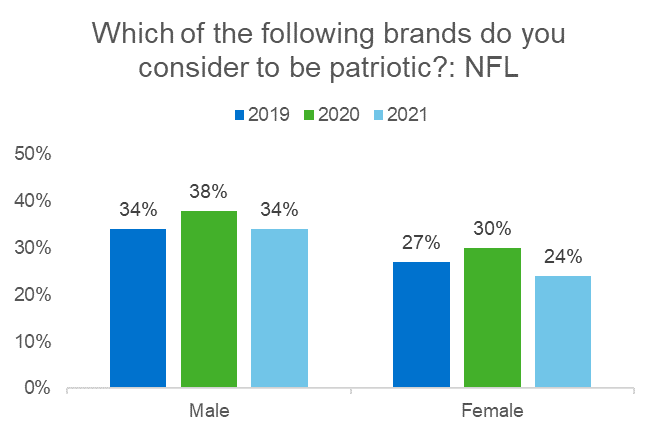
When segmented by political party, we see that Republican respondents have seen more considerable changes in their opinion toward the NFL over time. From 2019 to 2020, Republican perception of the NFL as a patriotic brand increased by 6%, and from 2020 to 2021 it dropped by 13%. On the other hand, Democrats have remained fairly consistent in their perception of the NFL as patriotic, experiencing only a 1% decrease from 2020 to 2021.
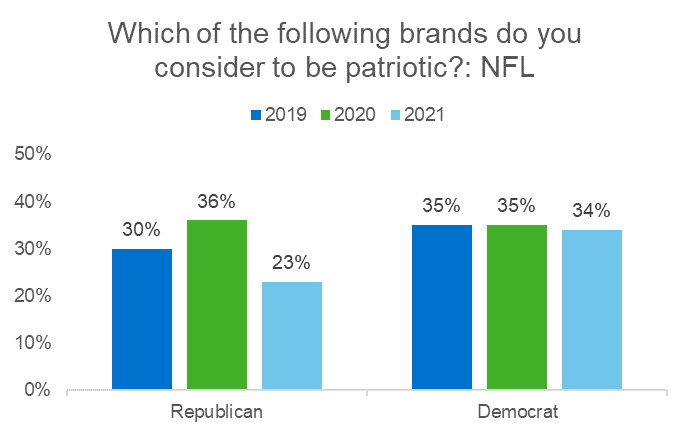
Looking at respondents’ income, the NFL’s perceived patriotism has decreased in the past year by 3% for respondents earning more than $75K annually, while it has decreased by 6% for those earning less than $75K. Respondents earning more than $75k annually tend to rate the NFL as patriotic more than those earning less than $75K.
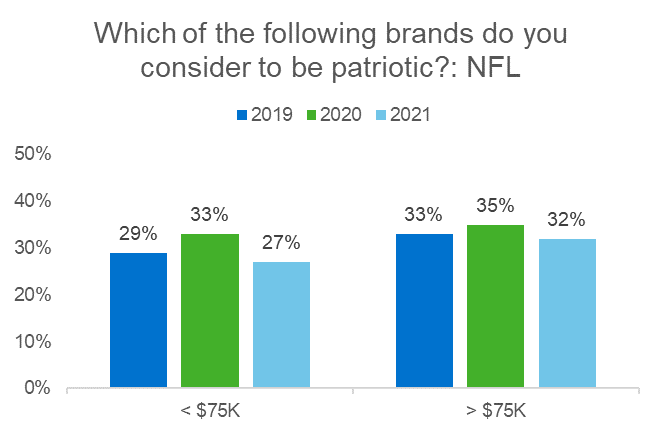
When segmented by region, we see that each region experienced a 5% decrease in consideration of the NFL as patriotic in the past year, except for the West which experienced a 7% decrease.
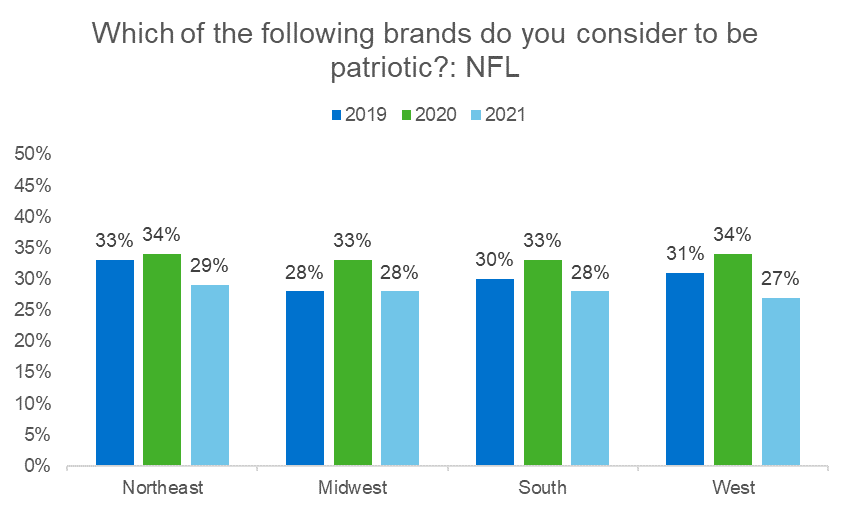
NRA
Overall, the NRA has experienced a consistent decrease in its perceived patriotism since 2019, which may be attributed to ongoing issues in the US around gun control.
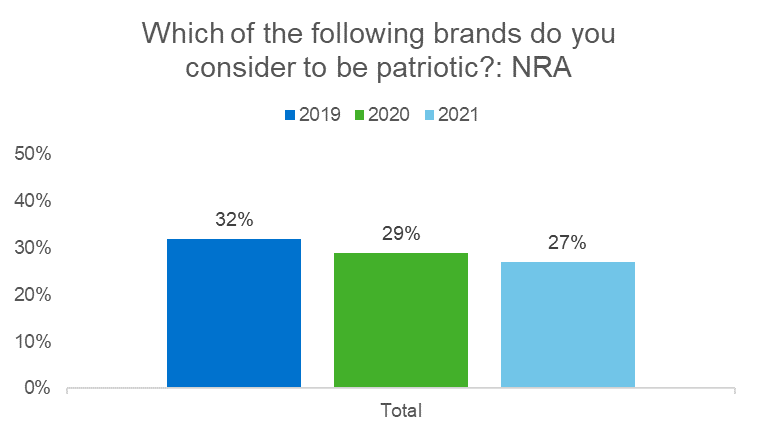
In the past year, males’ consideration of the NRA as patriotic has decreased by 3%, while that of females has decreased by 1%.

The proportion of Republicans and Democrats who consider the NRA a patriotic brand has remained steady over the past two years, with Republicans at 47% and Democrats at 15% in 2021.
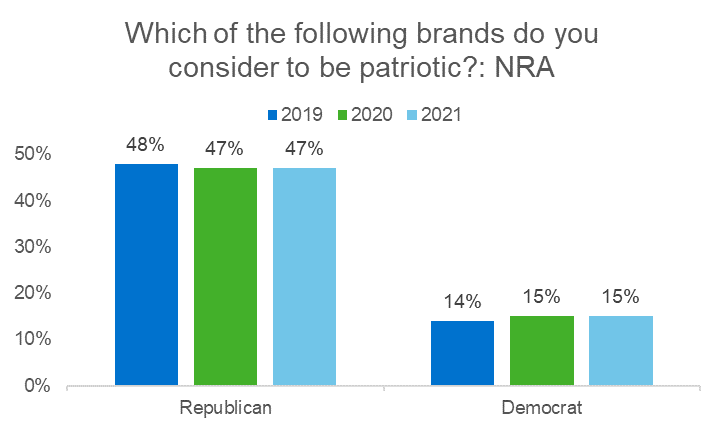
Respondents earning less than $75K experienced a 3% decrease in perceived patriotism of the NRA in the past year, whereas those earning more experienced only a 1% decrease.
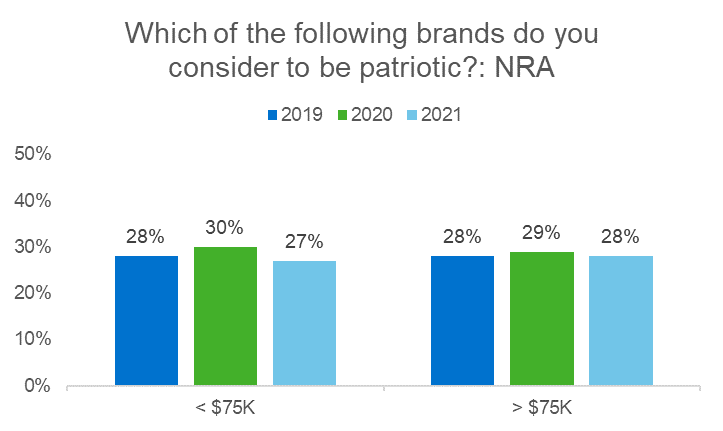
Consideration of the NRA as patriotic decreased in each region from 2020 to 2021. The West saw the greatest decrease, followed by the Northeast.
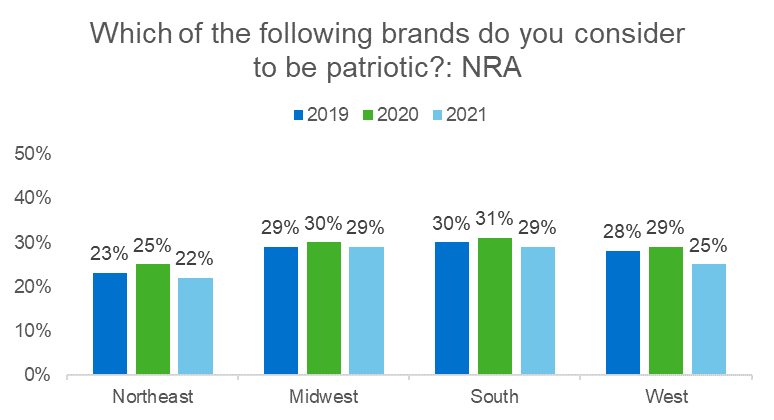
The Democratic Party
The Democratic Party had a 2% increase in perceived patriotism from 2020 to 2021, which may be related to the transition from a Republican president to a Democratic president.
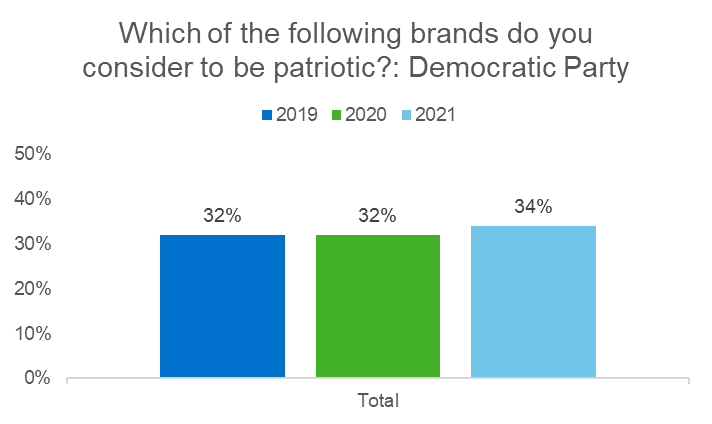
While both male and female perception of the Democratic Party as patriotic has increased since 2019, females’ consideration of the Democratic Party as patriotic has remained the same over the past year, while that of male respondents has increased by 4%.
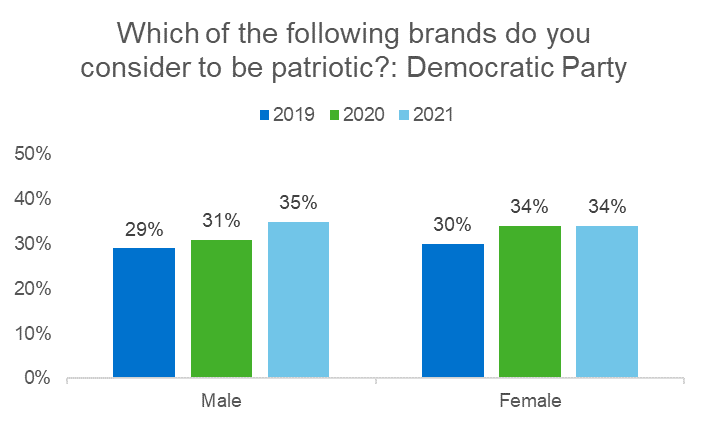
The proportion of Republicans who see the Democratic Party as patriotic is consistently lower than that of Democrats. Since 2020, Republican perception of the Democratic Party as patriotic has remained at 17%, while Democrat respondents saw a 1% decrease in their consideration of the Democratic Party as patriotic.
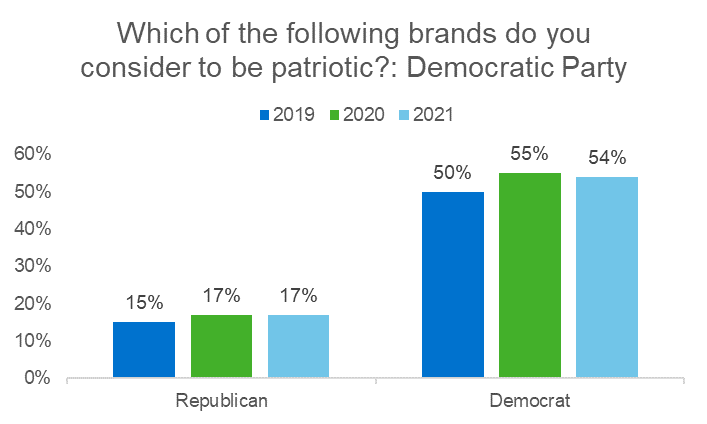
In the past year, those with income less than $75K saw a 1% decrease in perceived patriotism of the Democratic Party, whereas those with income greater than $75K saw a 4% increase.

All regions have experienced an increase in the proportion of respondents who believe the Democratic Party to be patriotic since 2019. From 2020 to 2021, the Northeast experienced a 4% increase, while the Midwest saw no change.

The Republican Party
The Republican Party had a 4% decrease in perceived patriotism from 2020 to 2021, which may also correspond with the transition from a Republican president to a Democratic president.
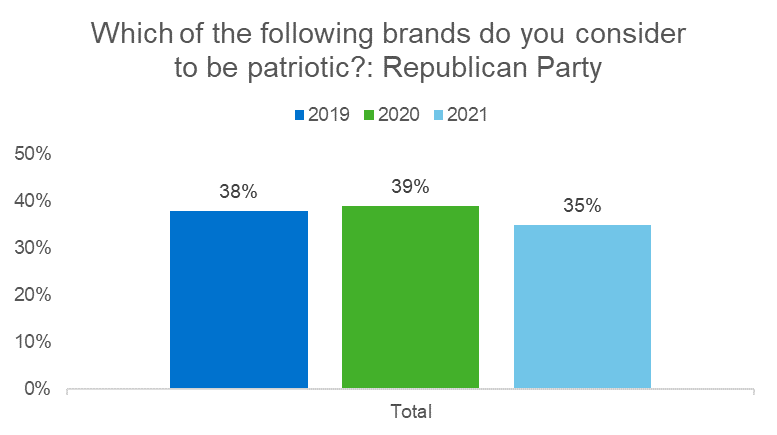
While both genders had an increase in perceived patriotism of the Republican Party from 2019 to 2020, male respondents saw a 7% decrease from 2020 to 2021, and female respondents saw a 2% decrease.
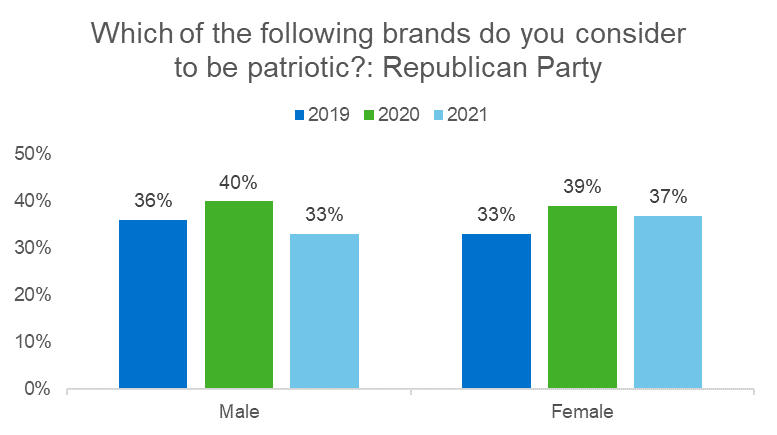
Republicans consistently rate the Republican Party as patriotic more than Democrats, however both parties saw a slight decrease in their perceived patriotism of the Republican Party over the past year.
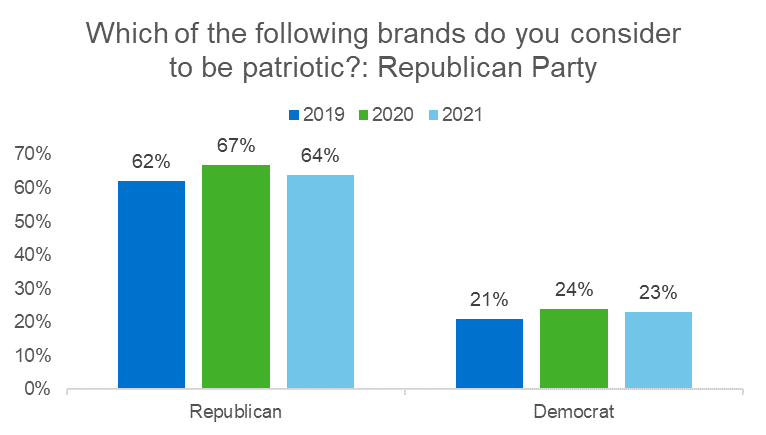
Those with income less than $75K experienced a 2% decrease since 2020 in consideration of the Republican Party as patriotic, while those with income greater than $75K experienced a 7% decrease.

All regions saw a decrease in perceived patriotism of the Republican Party in the past year, with the Northeast experiencing the greatest decrease at 6%.

New York Times
The New York Times saw a consistent decrease in perceived patriotism from 2019 to 2021, with a 3% change overall.

Males seem to have experienced a greater decrease in their consideration of The New York Times as patriotic over time than females have. From 2019 to 2021, male respondents saw a 5% decrease, compared to 3% with female respondents.
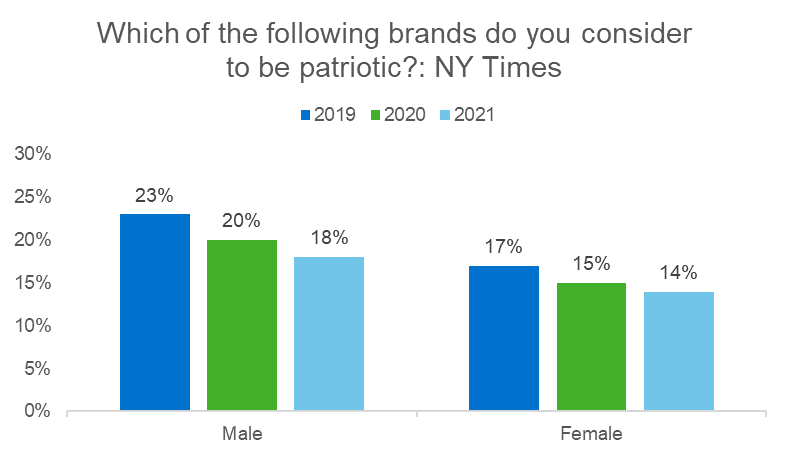
When segmented by political party, there is a visible difference between Republican and Democratic attitudes towards whether The New York Times is a patriotic brand. In 2021, there was a 12-point difference, with 9% of Republicans and 21% of Democrats considering The New York Times to be patriotic. Both parties have experienced a consistent decrease since 2019.
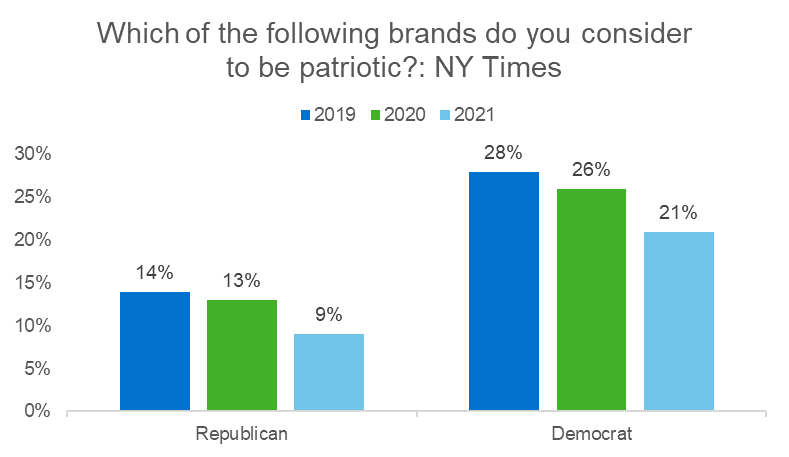
There is also a noticeable difference in perceived patriotism of The New York Times between those earning less than $75K and greater than $75K annually; it appears that those earning more are more likely to consider The New York Times patriotic. Since 2020, those earning less than $75K saw a 3% decrease and those earning more than $75K saw a 1% increase in perceived patriotism of The New York Times.
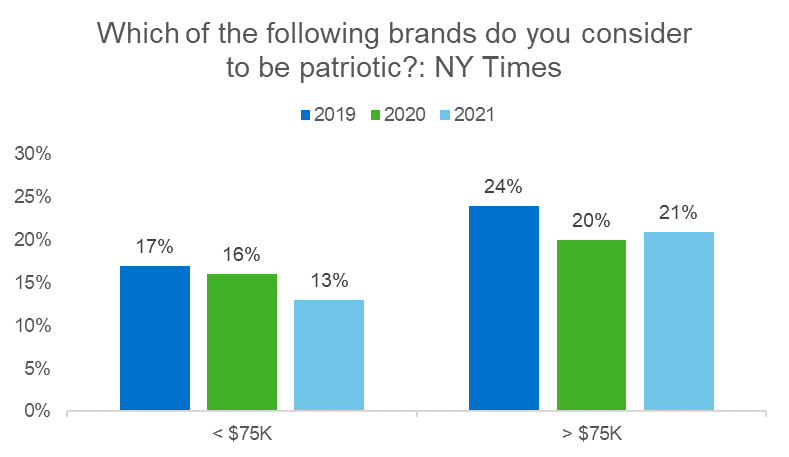
When segmented by region, we see that while all regions have experienced a steady decrease in their perception of The New York Times as patriotic over the past two years, the Northeast tends to see The New York Times as more patriotic than other regions.

Brand perception is constantly changing and is something that should be studied regularly. Check out last year’s blog on brands and patriotism to see how brand perception changed from 2019 to 2020 and download our 2021 Sample Landscape report to learn more about brand awareness and perception.




